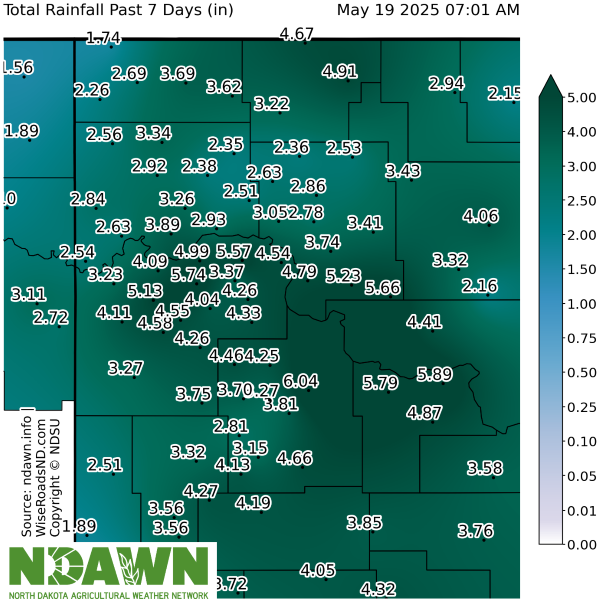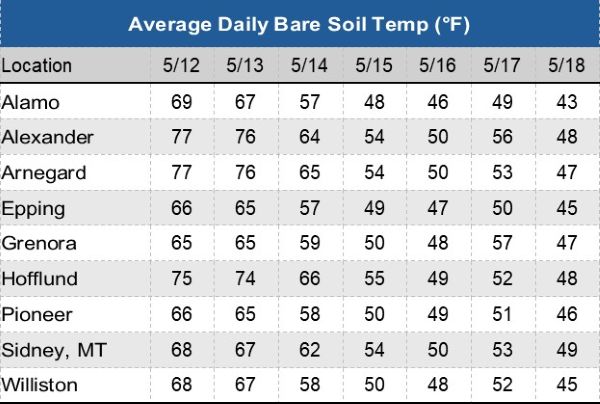Agronomy Update
May 19, 2025
NDAWN Growing Degree Day Modeling Tools
With the recent rainfall, many of us have had a welcome break—an ideal opportunity to catch up and prepare for the weeks ahead. Now is a great time to use the NDAWN Growing Degree Day (GDD) tool to estimate your crop’s current growth stage and plan for upcoming in-crop spraying.GDD models are available for a variety of crops, including barley, canola, corn, soybean, sunflower, and wheat. To access the tool, visit the NDAWN website, click on the “Applications” tab, and explore the range of available tools, including the various GDD models.
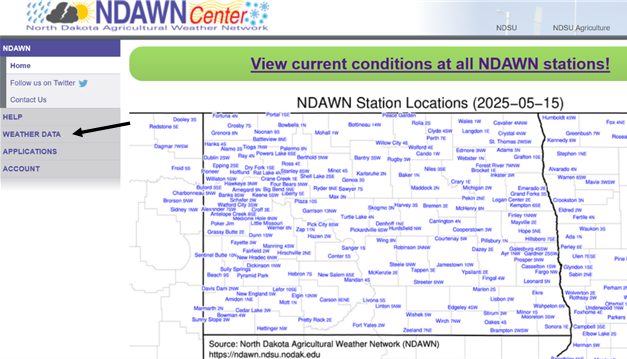
For wheat, you have two options: “Wheat GDD/Midge GDD” and “Wheat GDD Multiple Planting Dates.” The Multiple Planting Dates tool is especially useful if you have several wheat planting dates across your farm.
To get started:
1. Select “Wheat GDD Multiple Planting Dates.”
2. A new screen will appear where you can:- Choose your location
- Enter each of your planting dates
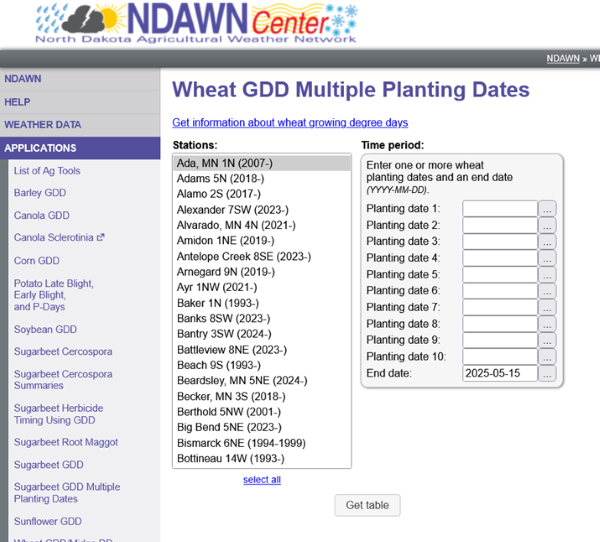
Once the table is generated, you’ll see a summary of the GDD data for each planting date. You can also click “Export CSV File” to download the data as an Excel-compatible file, making it easy to save and reference later.
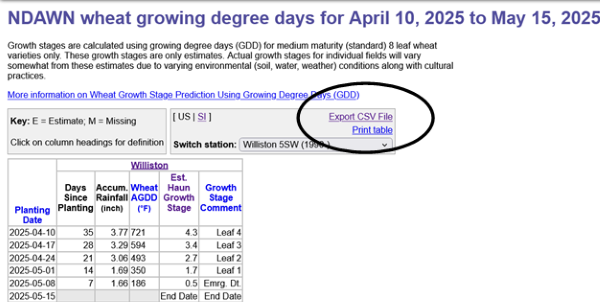
In the table I generated, I entered weekly planting dates ranging from April 10 to May 8. For crop spray timing decisions, we focus on the “Growth Stage Comment” section. The table also includes days since planting and accumulated rainfall for each planting date.
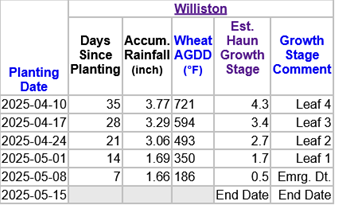
Based on the tool’s estimates, the wheat planted on April 10 is currently at the 4-leaf stage, while the wheat planted last week has just emerged. This aligns closely with what I observed in durum fields planted around April 17, which were at the 3-leaf stage as of last
week.
For in-crop spraying, applications can begin as early as the 1- to 2-leaf stage, depending on the product used. However, you may want to delay and allow a more complete weed flush before application. With the recent rainfall, we could see a significant flush of weeds once temperatures rise again.
Tolvera, a new product on the market, can be applied from the 1-leaf stage up to jointing. That said, the application window may be narrower depending on your tank mix partner. For example, a mix of Tolvera and 2,4-D should only be applied from the 3-leaf (tillering) stage to jointing (growth stage figure below, NDSU Weed Guide).
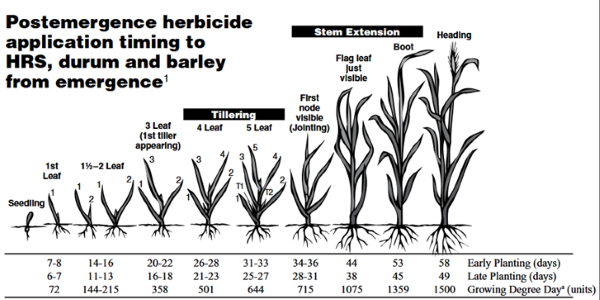
Page 16 of the NDSU Weed Guide is an excellent resource for comparing product mixes and determining the appropriate application window. However, it’s always important to double-check the product label for specific guidelines. Spraying outside the recommended window can have negative consequences. Applying too early may result in missing key weeds, while spraying too early or too late can cause crop injury or yield loss. For instance, spraying 2,4-D too early can interfere with the tillering process, leading to significant yield reduction. Timing also needs to balance weed size with crop size, as it's typically most effective to target small weeds before the crop canopy becomes too dense.
Effective weed management is about applying the right product at the right time. By staying on top of your crop's growth stage and keeping an eye on the weather, you can plan your herbicide applications more effectively and minimize the risk of crop damage or missed weeds.
Dr. Audrey Kalil, Agronomist/Outreach Coordinator
Missed Your Pre-Emerge? Rescue Options for Broadleaf Weeds
Dry springs can leave your pre-emergent herbicide stranded on the soil surface or tied up in crop residue, creating the perfect storm of tough, hardened weeds and no rain to activate your residual. Rather than watching escapes take over, consider a targeted post-emergent approach. Below are concise, crop-specific guidelines for chickpeas, field peas, lentils, and conventional soybeans.
Disclaimer: All products listed are labeled for the uses described, but crop injury is possible. Apply at your own risk!
Chickpeas
Your one broadleaf option: Tough 5EC- Mode of Action: Group 6, contact only, needs high coverage.
- Carrier Volume: Minimum 20 gallons/acre.
- Timing: Sunny, clear days improve activity.
- Weed Control: Excellent on lambsquarters & pigweed; fair on kochia & Russian thistle.
- Crop Safety: Historically low visible injury on chickpeas.
- Rate: 24 oz/acre Tough 5EC (never lower).
- Adjuvants: Add 2.5% v/v ammonium sulfate + 0.5% v/v NIS or COC.
Please Note: This is an expensive herbicide and should only be used in situations that broadleaf pressure will impact yield **
Field Peas
Options: Basagran, Beyond Xtra, or Varisto (combo of Basagran & Beyond Xtra)- Modes of Action: Group 6 (Basagran) and Group 2 (Beyond Xtra)
- Carrier Volume: ≥ 15 gallons/acre for best efficacy and reduced crop response.
- Timing: Avoid applications when temps exceed 80°F or humidity is greater than 80% to limit pea injury.
- Weed Control: Basagran is better on lambsquarter and okay on buckwheat. Beyond Xtra is similar with improved efficacy on lanceleaf sage. Varisto is a combination of these two products.
- Rates: Basagran 16 oz/ac, Beyond Xtra 2 oz/ac, Varisto 11 oz/ac. Add 5 oz/ac of Basagran to Varisto to get to the 16 oz/ac rate of Basagran and sharpen control of lambsquarters and buckwheat
- Adjuvants: COCs (e.g., SuperB HC) over MSOs for greater crop safety.
Lentils
Rescue mix: Tough 5EC + MetribuzinWarning: Expect crop response (visible and possible severe injury) with any post-apply.
- Modes of Action: Group 6 and Group 5
- Carrier Volume: ≥ 15 gallons/acre for best efficacy and reducedcrop response.
- Rates: 7 oz/acre Tough 5EC + 2 oz/acre metribuzin (4 lb/gal).
- Adjuvants: 0.25% v/v non-ionic surfactant; switch to 1% v/v COC if adding grass herbicides.
- Environmental Caution: High heat & humidity amplify injury.
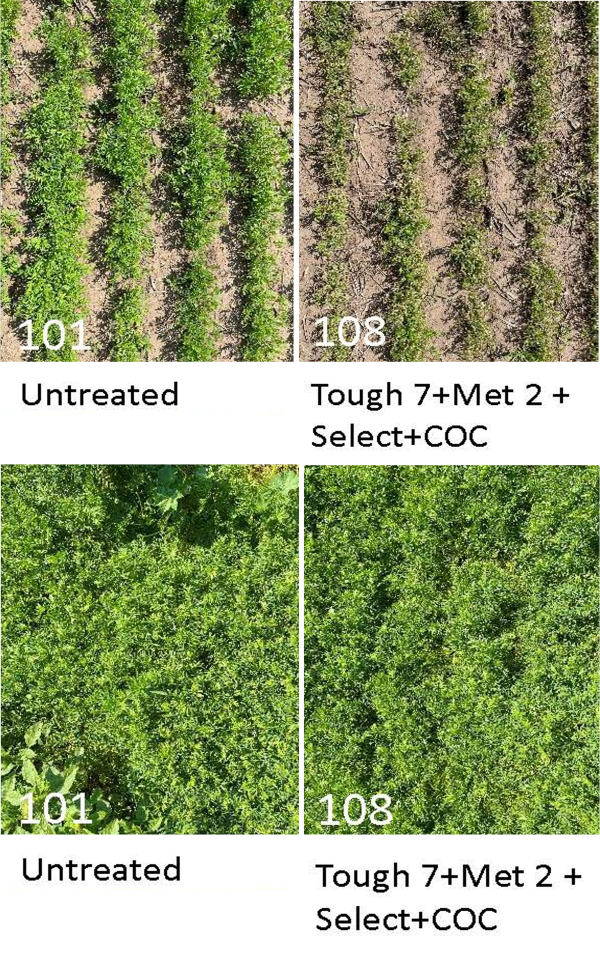
Conventional Soybeans
Flexible post-emerge broadleaf control:- Standard: Basagran + Beyond Xtra for mixed broadleaves.
- Kochia Special: Ultra Blazer (contact Group 14) excels on smallkochia.
- Expect "Burn": Leaves will scorch but new growth emerges post-stress. My advice is to step away for 5–7 days after application andresist the urge to re-enter fields while soybeans recover.
- Carrier Volume: ≥ 15 gal/acre for uniform coverage.
- Rate & Adjuvant: 16 oz/acre Ultra Blazer + MSO (e.g., Destiny HC).
Good luck out there!
Kyle Okke, Crop Consultant, CCA
Agile Agronomy LLC & Agronomists Happy Hour Podcast
Test for Group 14 Resistance
The National Agricultural Genotyping Center (NAGC) based in Fargo conducted genetic testing on kochia populations across North Dakota in 2024, to determine the prevalence of herbicide resistance. This was a free test available to anyone who wanted to submit a sample, and was sponsored by the ND Soybean Council, the ND Corn Utilization Council and the ND Department of Agriculture. Through the tests they developed, they are able to identify genetic markers for resistance to Group 2 (ex. Beyond, Raptor), Group 9 (glyphosate), and Group 14 (ex. Valor, Aim, Sharpen) based on leaf tissue samples.
The maps below, provided by the NAGC, show the number of resistant individual plants out of the total number of plants tested. When I discussed these results with Dr. Brian Jenks, NDSU weed scientist, he mentioned that the genetic test for group 2 resistant individuals is likely not able to capture all the different forms of resistance that exist to that mode of action and so this test probably underestimates the prevalence of group 2 resistant kochia. Presently, 7% of the population tested is resistant to all three modes of action.
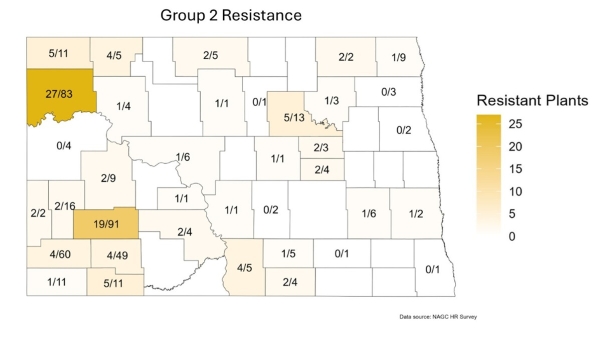
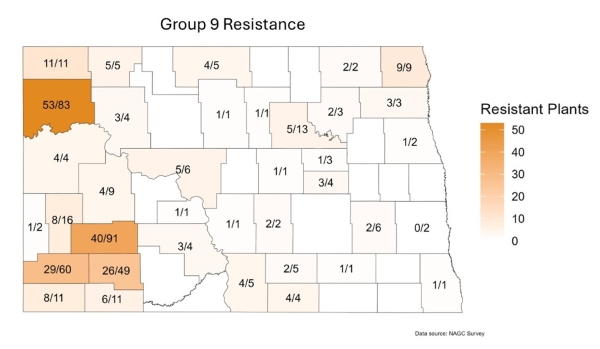
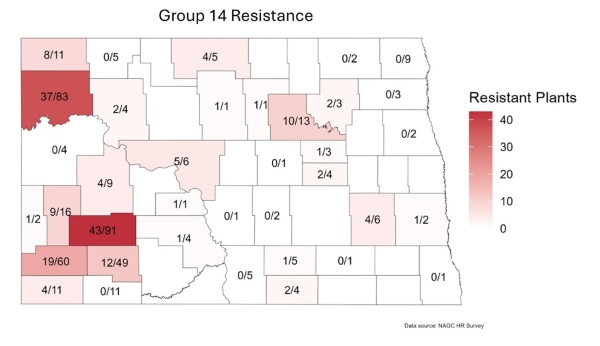
Group 14 resistance was found in 44% of the plants tested in Williams County last year, so some of the population remains susceptible. It will be very important moving forward that we keep susceptible individuals in the population to prevent complete resistance to this herbicide group. We can achieve this by stacking multiple modes of action within seasons, and using different crop rotations and herbicide groups across seasons to manage kochia. Continuing to exclusively reply upon a combination of Round Up and group 14 chemistries in our pulse crops will likely not control kochia populations in the near future. Below is an example of what group 14 looks like in a population tested by Dr. Brian Jenks (photo from Dr. Jenks’ presentation at Wild World of Weeds). Some products used in soybeans still appear to be working better than the products we use in pulse crops.
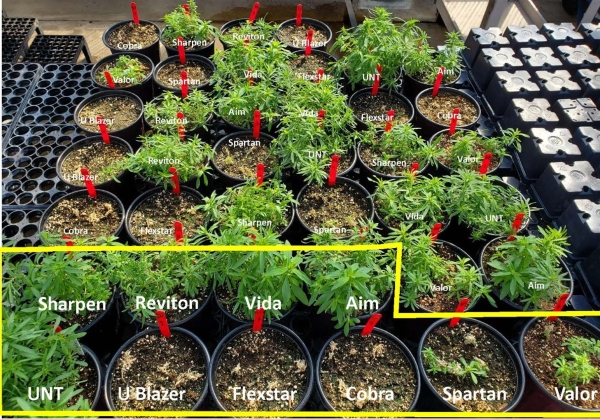
The NAGC will be offering this free testing again in 2025, thanks to the commodity group and state funding, and I encourage everyone to participate whether or not you believe you have problems with group 14 resistance on your farm. The more plants get submitted, the better we understand what percentage of the population is resistant. You can submit a sample yourself to the lab directly or ask a member of our Agronomy team to help. We have submission envelopes available at our Williston Agronomy location, and you can also get them from NDSU County Extension or from the NAGC.
Feel free to reach out with any questions.
Dr. Audrey Kalil, Agronomist/Outreach Coordinator
